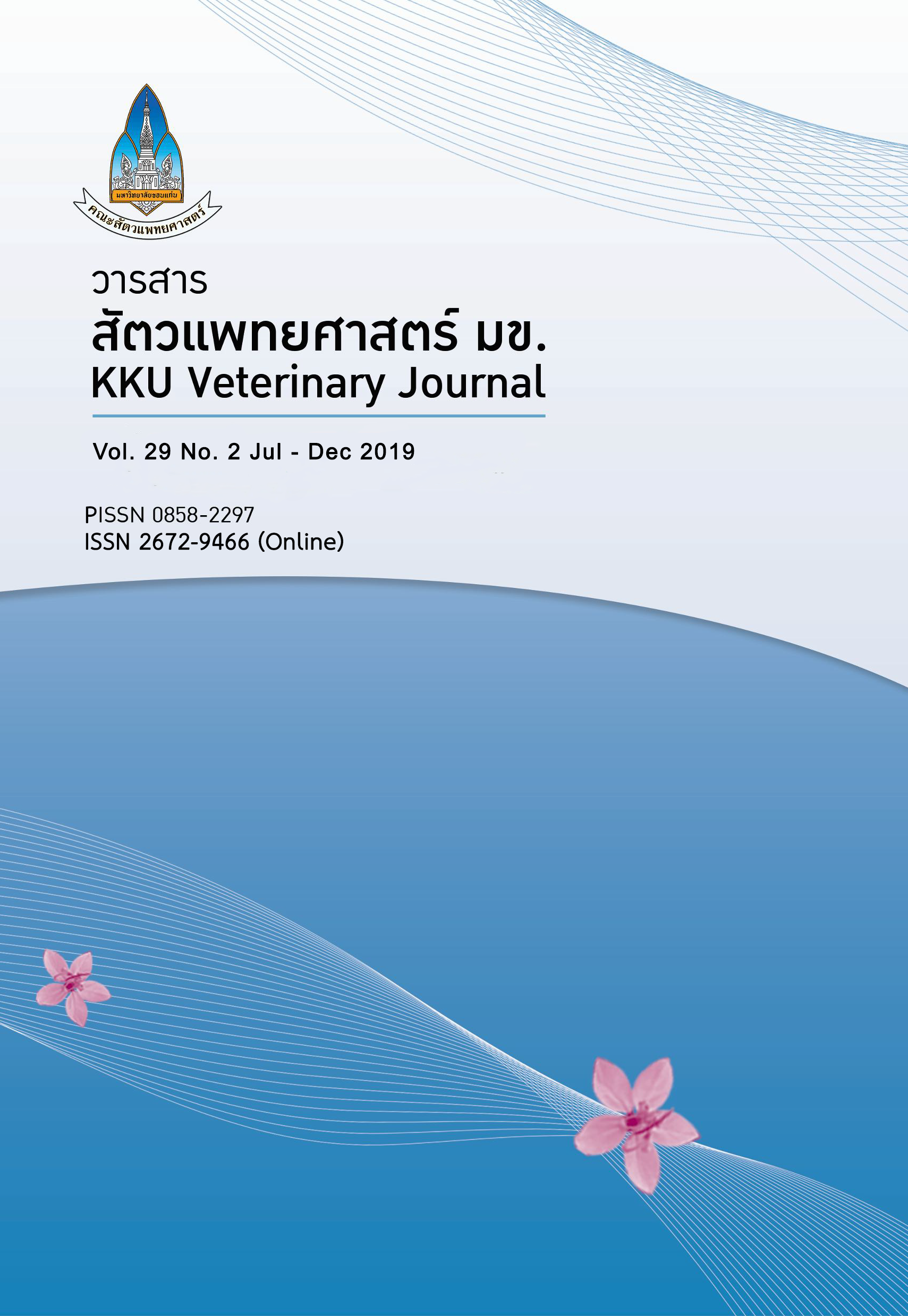ปัจจัยเสี่ยงของการปนเปิ้อนเชื้อสเตร็พโตค็อกคัส ซูอิส ในโรงฆ่าสัตว์ในจังหวัดมหาสารคาม
Main Article Content
บทคัดย่อ
วัตถุประสงค์ เพื่อประเมินปัจจัยเสี่ยงของการปนเปิ้อนเชื้อสเตร็พโตค็อกคัส ซูอิส ระหว่างโรงฆ่าสัตว์ที่มีทะเบียนกับโรงฆ่าสัตว์ที่ไม่มีทะเบียนในจังหวัดมหาสารคาม
อุปกรณ์และวิธีการ เก็บตัวอย่างจากต่อมทอนซิล เลือด เนื้อ อุปกรณ์และผู้ปฎิบัติงานในโรงฆ่าสัตว์จำนวน 500 ตัวอย่าง จากโรงฆ่าสัตว์ที่มีทะเบียน 5 แห่งและไม่มีทะเบียน 5 แห่ง ใช้แบบสอบถามร่วมกับการสังเกตเพื่อเก็บข้อมูลโรงฆ่าสัตว์ ตัวอย่างถูกนำไปเพาะเชื้อแบคทีเรียในห้องปฏิบัติโดยวิธีมาตรฐานและแยกชนิดเชื้อโดยวิธีพีซีอาร์ ใช้การประเมินปัจจัยเสี่ยงจากองค์ประกอบของโรงฆ่าสัตว์ประกอบด้วย การทำสลบ การตัดแต่งซาก การผ่าซีกซาก การแขวนซาก ต่อการพบเชื้อสเตร็พโตค็อกคัส ซูอิส
ผลการศึกษา พบเชื้อสเตร็พโตค็อกคัส ซูอิสจำนวน 20 ตัวอย่างจากตัวอย่างทั้งหมด 500 ตัวอย่าง คิดเป็นร้อยละ 4 โดยปนเปื้อนในตัวอย่างทอนซิลจำนวน 18 ตัวอย่างและอีก 2 ตัวอย่างจากอุปกรณ์ในโรงฆ่า เป็นตัวอย่างจากโรงฆ่าสัตว์ที่ไม่มีทะเบียน 16 ตัวอย่างและอีก 4 ตัวอย่างจากโรงฆ่าสัตว์ที่มีทะเบียน จากการแยกชนิดเชื้อสเตร็พโตค็อกคัส ซูอิส พบชนิดซีโรไทป์ 2 จำนวน 4 ตัวอย่างและ ซีโรไทป์ไทม์ 1 พบจำนวน 16 ตัวอย่าง พบความเสี่ยงของการพบเชื้อกลุ่มสเตร็พโตค็อกคัสในโรงฆ่าที่ไม่มีทะเบียนสูงกว่าโรงฆ่าสัตว์ที่มีทะเบียนอย่างมีนัยสำคัญ (Odds ratio = 1.44, (CI=1.00 – 2.09, P < 0.04) และพบความเสี่ยงที่จะพบเชื้อสเตร็พโตค็อกคัส ซูอิส ในโรงฆ่าสัตว์ที่ไม่มีทะเบียนสูงกว่าโรงฆ่าสัตว์ที่มีทะเบียนอย่างมีนัยสำคัญ (Odds ratio = 9.62, CI=2.20 - 41.91, P < 0.002)
สรุปผล โรงฆ่าสัตว์ที่ไม่มีทะเบียนมีโอกาสปนเปื้อนเชื้อทั้งกลุ่มสเตร็พโตค็อกคัสและเชื้อสเตร็พโตค็อกคัส ซูอิสสูงกว่าโรงฆ่าสัตว์ที่มีทะเบียน แต่ผู้บริโภคควรระมัดระวังในการเลือกซื้อเนื้อสุกร และควรจะบริโภคเนื้อที่ปรุงสุกเพื่อลดปัญหาการเกิดโรค
Article Details
เอกสารอ้างอิง
Choi, Y.M., Park, H.J., Jang, H.I., Kim, S.A., Imm, J.Y., Hwang, I.G., Rhee, M.S. 2013. Changes in microbial contamination levels of porcine carcasses and fresh pork in slaughterhouses, processing lines, retail outlets, and local markets by commercial distribution. Research in Veterinary Science 94, 413–418
Gill, C.O., Bryant, J.1992. The contamination of pork with spoilage bacteria during commercial dressing, chilling and cutting of pig carcasses. International Journal of Food Microbiology 16, 51–62.
Marois, C., Bougeard, S., Gottschalk, M., Kobisch, M. 2004. Multiplex PCR assay for detection of Streptococcus suis species and serotype 2 and 1/2 in tonsils of live and dead pigs. Journal of Clinical Microbiology 42(7), 3169 – 3175.
Nation Institute of Animal Health. 2004. Standard Diagnosis Manual of Livestock Disease in Thailand. Nation Institute of Animal Health, Development, Ministry of Agriculture and Cooperatives, Thailand
Noppon, B., Khaeng, S., Sopa, A., Phuaram, P., Wongsan, R., Laohasinnurak, T. 2014. Streptococcus suis serotype 2 in uncooked pork meat products in Khon Kaen, northeastern Thailand, and their antimicrobial profiles. International Journal of Scientific & Engineering Research 5(9), 1130-1133
Pathanasophon P, Narongsak W, Worarach A, Yuwapanichsampan S, Sagarasaeranee P. 2009. Prevalence of Streptococcus suis in pigs and pig farmers in 11 provinces in the East and the West of Thailand. Journal of the Thai Veterinary Medical Association under the Royal Patronage 60(1-3), 49-62.
Quinn, P.J., Carter, M.E., Markey, B., Carter, G.R. 1994. Clinical Veterinary Microbiology. Mosby, Elsevier Lts. Spain. 388pp.
Smith, H.E., van Bruijnsvoort, L., Buijs, H., Wisselink, H.J., Smits, M.A. 1999a. Rapid PCR test for Streptoccoccus suis serotype 7. FEMS Microbiology Letters 178, 265-270.
Smith, H.E., Venbergen, V., Velde, J., Damman, M., Wisselink, H.J., Smits, M.A. 1999b. The cps genes of Streptococcus suis serotypes 1,2, and 9 Development of rapid serotype-specific PCR assays. Journal of Clinical Microbiology 37(10), 3140 – 3152.
Wertheim, H.F., Nghia, H.D., Taylor, W., Schultsz, C. 2009. Streptococcus suis an
emerging human pathogen. Clinical Infectious Diseases 48, 617-625.
Wisselink H.J, Smith H.E, Stockhofe-Zurwieden N., Peperkamp K., Vecht U. 2000. Distribution of capsular types and production of muramidase-released protein (MRP) and extracellular factor (EF) of Streptococcus suis strains isolated from diseased pigs in seven European countries. Veterinary Microbiology.74 (3), 237–48.
Zhang, D., Du, N., Ma, S., Hu, Q., Lu, G, Chen, W., Zeng, C. 2014. In vitro transcriptome analysis of two Chinese isolates of Streptococcus suis serotype 2. Genomics, proteomics & bioinformatics 12(6), 266-275.
Zhang, C.P., Ning, Y.B., Zhang, Z.Q., Song, L., Qiu, H.S., Gao, H.Y., Fan, X.Z. 2009. Prevalence of Streptococcus suis isolated from clinically healthy sows in China. Agric. Sci. China 8: 638–642.


